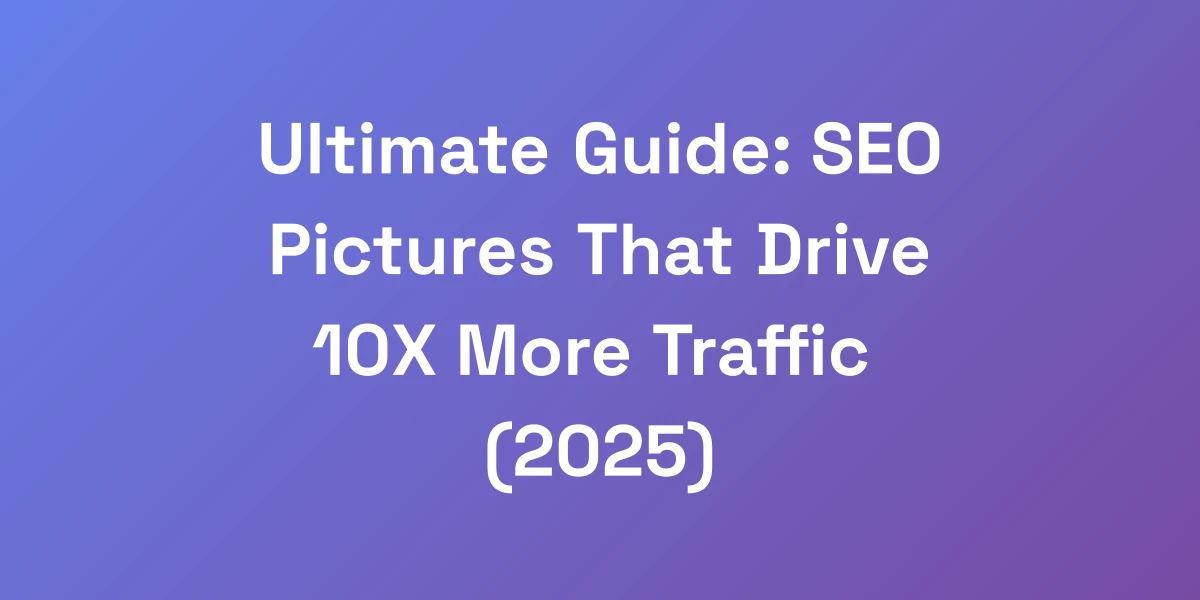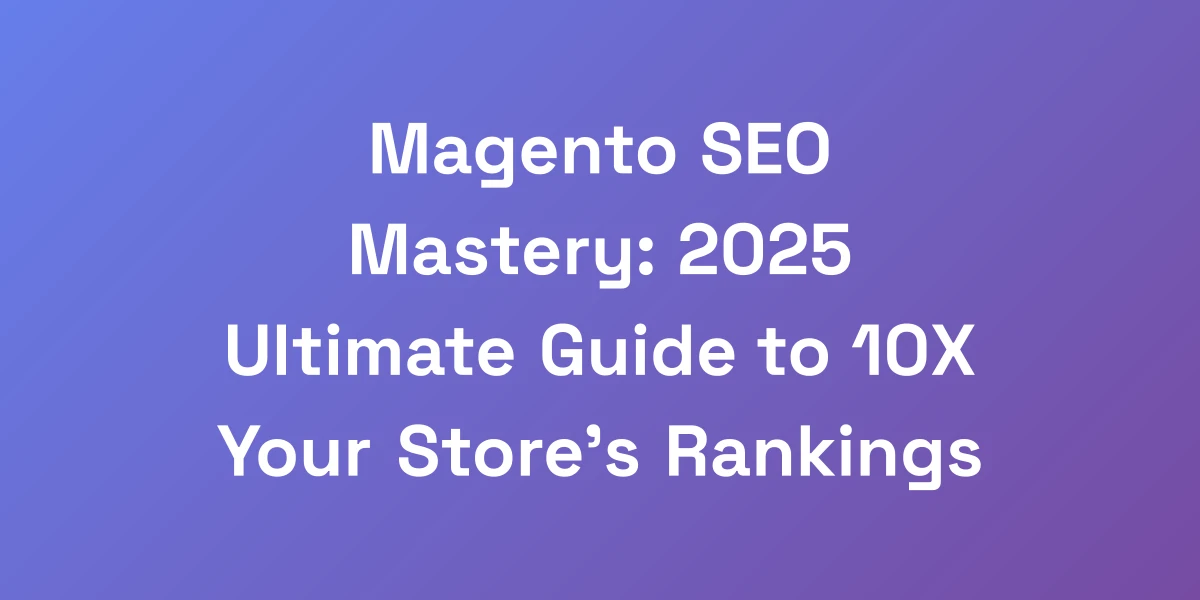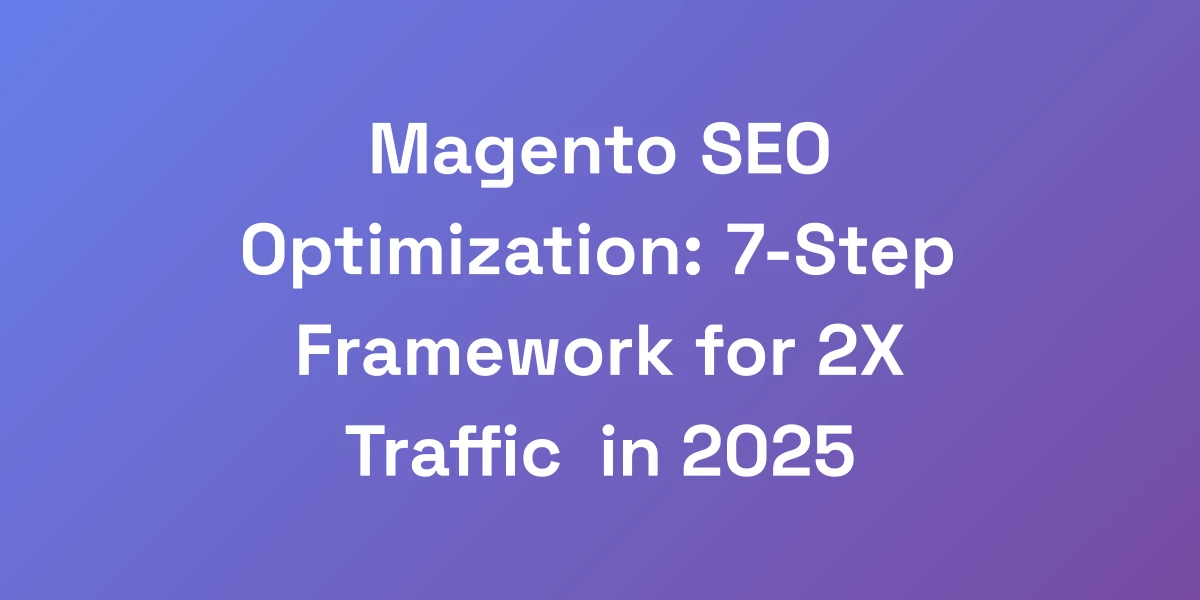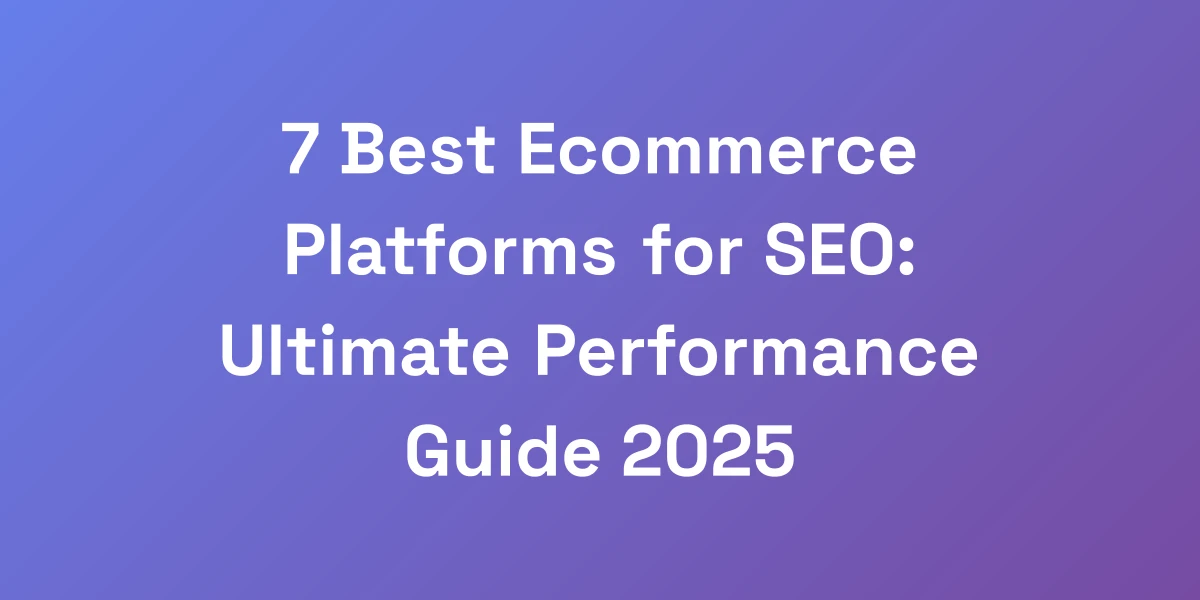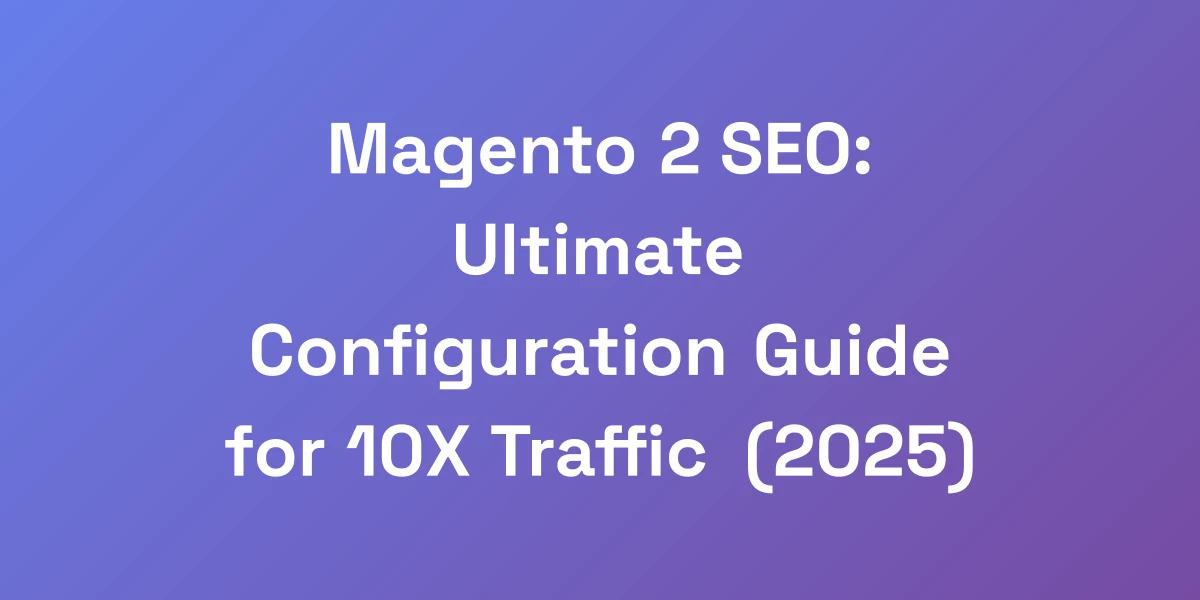
Magento 2 SEO: Ultimate Configuration Guide for 10X Traffic (2025)
Mar 31, 2025 | By [email protected]
Why Most Magento 2 Stores Fail at SEO (And How to Fix It)
Listen up. I’m about to share something that 95% of Magento store owners get dead wrong. They think installing Magento 2 means their SEO is handled. That’s like saying buying a Ferrari means you’re ready for F1.
The truth? Your store is bleeding money right now because of basic SEO mistakes. But here’s the good news: we’ve helped dozens of stores go from invisible to unstoppable using these exact Magento 2 SEO strategies.
Let’s fix your store’s SEO today.
Common SEO Mistakes Killing Your Store’s Potential
Ever wondered why your Magento 2 store isn’t ranking despite all the effort? It’s frustrating, right? Let’s break down the common pitfalls:
- Ignoring URL Structure: Messy URLs confuse search engines and users alike.
- Neglecting Meta Tags: Missing or duplicate meta descriptions can cripple your SEO.
- Overlooking Mobile Optimization: With 46% of traffic from mobile, a non-responsive site is a deal-breaker.
- Duplicate Content: Multiple URLs leading to the same content dilute your SEO strength.
These mistakes aren’t just minor glitches. They can significantly hinder your store’s visibility and revenue.
The Real Cost of Poor Magento 2 SEO Implementation
Let’s talk numbers. Poor SEO isn’t just a lost opportunity; it’s a direct hit to your bottom line.
- Reduced Traffic: Organic traffic can drop by up to 50% with poor SEO practices.
- Lower Conversion Rates: Users stuck in a bad experience are less likely to buy.
- Higher Bounce Rates: Slow and unoptimized sites send visitors running.
Imagine pouring resources into your store only to see flatline sales and wasted marketing spend. That’s the harsh reality of ignoring Magento statistics.
Quick Wins for Immediate SEO Impact
Ready to see some instant changes? Here are quick wins that can immediately boost your SEO performance:
- Optimize Your URLs: Simplify and include relevant keywords.
- Improve Meta Descriptions: Make them compelling and unique.
- Enhance Mobile Responsiveness: Ensure your site looks great on all devices.
- Fix Broken Links: Regularly audit and repair any broken URLs.
These small tweaks can lead to a significant uptick in your search engine rankings and user engagement.
Understanding Magento 2’s Native SEO Capabilities
Magento 2 isn’t just a platform; it’s a powerhouse with built-in Magento SEO features. But are you leveraging them fully?
- SEO-Friendly URLs: Magento 2 allows for clean, customizable URLs that search engines love.
- Meta Data Management: Easily manage title tags, meta descriptions, and keywords directly from the backend.
- XML Sitemap Generation: Automatically create and update sitemaps to ensure all your pages are indexed.
- Robots.txt Configuration: Control what search engines should or shouldn’t crawl.
Understanding and utilizing these native capabilities can set the foundation for a robust SEO strategy.
Setting Up Your SEO Success Framework
Building a strong SEO framework is like laying down the tracks for a high-speed train. Here’s how we do it:
- Comprehensive Keyword Research: Identify the keywords that matter most to your audience.
- Content Strategy: Develop content that aligns with user intent and drives engagement. Implement content marketing for small businesses to maximize your content’s impact.
- Technical Optimization: Ensure your site is fast, secure, and easily navigable.
- Continuous Monitoring: Regularly track performance and adjust strategies as needed.
This structured approach ensures that every aspect of your SEO is aligned with your business goals, driving sustained growth.
Essential Magento 2 Backend SEO Configurations
Here’s the brutal truth about Magento 2 SEO: The default settings are leaving money on the table. I’m talking about thousands in lost revenue.
But we’ve cracked the code on the exact backend configurations that turn Magento 2 into an SEO powerhouse.
We’re going to dive into the specific settings that matter, not the fluff most “experts” push. These are the same configurations that helped our clients achieve 300% organic traffic growth.
Navigating to Critical SEO Settings
First things first, let’s locate the vital SEO settings in Magento 2. Head over to the backend dashboard, then follow this path:
- Stores > Configuration
- Under Catalog, select Catalog
- Navigate to the Search Engine Optimization section
Here, you’ll find all the essential configurations needed to optimize your store’s SEO performance.
URL Structure Optimization
Your URL structure is the backbone of your SEO strategy. Clean, keyword-rich URLs can significantly improve your search rankings.
- Use Static URLs: Enable
Use Web Server Rewritesto removeindex.phpfrom URLs. - Include Keywords: Incorporate relevant keywords naturally within your URLs.
- Short and Simple: Avoid unnecessary parameters and keep URLs concise.
By refining your URL structure, you make it easier for search engines and users to understand and navigate your site.
Meta Data Templates Configuration
Meta data is crucial for conveying the relevance of your pages to search engines. Here’s how to set it up:
- Title Templates: Create dynamic title templates that include product names and primary keywords.
- Meta Descriptions: Develop compelling meta descriptions that encourage clicks.
- Canonical Tags: Ensure canonical URLs are correctly set to prevent duplicate content issues.
Proper meta data configuration can drastically improve your click-through rates and search rankings.
XML Sitemap Generation and Submission
An XML sitemap is a roadmap for search engines to crawl and index your site efficiently.
- Generate Sitemap: Magento 2 can automatically generate an XML sitemap. Ensure it’s enabled.
- Include All Important Pages: Make sure every critical page is included in the sitemap.
- Submit to Search Engines: Submit your sitemap to Google Search Console and Bing Webmaster Tools.
A well-structured sitemap ensures that all your pages are visible to search engines, boosting your organic presence.
Robots.txt Configuration
Your robots.txt file guides search engines on which pages to crawl and which to ignore.
- Disallow Unnecessary Pages: Prevent search engines from indexing admin panels, user accounts, and other non-essential pages.
- Allow Important Sections: Ensure key areas like product pages and categories are accessible.
- Regular Updates: Keep your robots.txt updated as your site structure evolves.
Proper robots.txt configuration helps in maximizing crawl efficiency and directing SEO efforts where they matter most.
Advanced Store Configuration Settings
For those who want to dive deeper, advanced store configurations can offer substantial SEO benefits.
- Implement Bread Crumbs: Enhance navigation and improve internal linking.
- Enable Rich Snippets: Use structured data to provide search engines with detailed information about your products.
- Set Up SEO-Friendly Navigation: Ensure your store’s navigation is intuitive and search-engine-friendly.
These advanced settings can give your Magento 2 store a competitive edge in search rankings.
Advanced On-Page SEO Techniques for Magento 2
Let’s get real about on-page SEO for Magento 2. Most store owners are playing checkers while their competitors are playing chess. We’re going to show you how to dominate your niche with advanced on-page techniques that 99% of stores ignore.
These aren’t theory – these are battle-tested strategies that have generated millions in revenue for our clients. Time to turn your product pages into conversion machines.
Product Page SEO Optimization
Your product pages are the heart of your e-commerce store. Optimizing them can significantly boost your SEO and sales.
- Unique Product Descriptions: Avoid duplicate content by writing original descriptions that highlight unique features.
- High-Quality Images: Use optimized images with descriptive alt texts to improve search visibility.
- Customer Reviews: Incorporate genuine reviews to build trust and provide fresh content.
By enhancing your product pages, you create a more engaging and search-friendly user experience.
Category Page Structure and Optimization
Category pages serve as gateways to your products. Optimizing them is crucial for site navigation and SEO.
- Clear Hierarchy: Organize categories logically to aid both users and search engines.
- Keyword-Rich Titles: Ensure category titles include relevant keywords.
- Descriptive Content: Add unique descriptions to each category to provide context and improve relevancy.
A well-structured category page can enhance user experience and boost your overall SEO performance.
Internal Linking Strategy
Internal links are the threads that connect your website, guiding users and search engines through your content.
- Strategic Linking: Link related products and categories to keep users engaged.
- Anchor Text Optimization: Use descriptive anchor texts that include target keywords.
- Limit Excessive Links: Avoid cluttering pages with too many links, which can dilute their effectiveness.
An effective internal linking strategy improves navigation, user engagement, and SEO.
Content Optimization for Featured Snippets
Featured snippets can catapult your site to the top of search results. Here’s how to optimize for them:
- Answer Specific Questions: Identify common queries in your niche and provide clear, concise answers.
- Use Structured Formatting: Employ lists, tables, and headings to make content easily digestible.
- Optimize for Voice Search: With the rise of voice assistants, ensure your content is conversational and direct.
By targeting featured snippets, you can gain prime visibility and drive more traffic to your store.
Schema Markup Implementation
Schema markup helps search engines understand your content better, leading to enhanced search results.
- Product Schema: Include details like price, availability, and reviews to enrich your listings.
- Breadcrumb Schema: Improve navigation and enhance search result displays.
- FAQ Schema: Answer common questions directly on your pages to capture voice search traffic.
Implementing schema markup can lead to rich snippets, which attract more clicks and improve your SEO.
Mobile SEO Optimization
With nearly half of your traffic coming from mobile, optimizing for mobile is non-negotiable.
- Responsive Design: Ensure your site adapts seamlessly to all screen sizes.
- Fast Load Times: Optimize images and minimize scripts to enhance mobile performance.
- Easy Navigation: Design intuitive menus and clickable elements for a smooth mobile experience.
Mobile optimization isn’t just about aesthetics; it’s a critical component of your SEO strategy.
Technical SEO Mastery for Magento 2
Technical SEO is where most Magento 2 stores completely drop the ball. But it’s also where the biggest opportunities lie.
We’ve seen stores double their traffic just by fixing technical SEO issues. We’re going to cover the exact technical optimizations that move the needle, including the hidden settings most developers miss.
This isn’t about theory – it’s about implementation that drives results.
Site Speed Optimization
Speed isn’t just a luxury; it’s a necessity. A slow site deters users and harms your SEO.
- Enable Caching: Use Magento’s built-in caching to reduce load times.
- Optimize Images: Compress images without sacrificing quality.
- Minify CSS and JavaScript: Reduce file sizes to speed up rendering.
Improving site speed can lead to lower bounce rates and higher rankings.
JavaScript and CSS Optimization
Heavy JavaScript and CSS can bog down your site. Here’s how to streamline them:
- Asynchronous Loading: Load scripts asynchronously to prevent blocking the rendering process.
- Combine Files: Merge CSS and JavaScript files to reduce HTTP requests.
- Remove Unused Code: Trim any unnecessary code that can slow down your site.
Optimizing JavaScript and CSS ensures a smoother, faster user experience.
Mobile-First Indexing Preparation
Google primarily uses the mobile version of your site for indexing and ranking. Here’s how to prepare:
- Ensure Consistency: Content on mobile should match the desktop version.
- Optimize Navigation: Make sure menus and links are easy to use on mobile devices.
- Improve Readability: Use legible fonts and appropriate font sizes for mobile screens.
Preparing for mobile-first indexing ensures your site remains competitive in search rankings.
Handling Duplicate Content
Duplicate content can confuse search engines and dilute your SEO efforts.
- Use Canonical Tags: Specify the preferred version of a page to prevent duplication.
- Avoid Printer-Friendly Pages: These can create unnecessary duplicates.
- Monitor for Duplicates: Regularly audit your site to identify and address duplicate content issues.
Managing duplicate content is essential for maintaining a strong, cohesive SEO strategy.
Advanced Canonical Tag Implementation
Canonical tags are your secret weapon against duplicate content. Here’s how to implement them effectively:
- Set on All Pages: Ensure every page, especially product and category pages, has a canonical tag.
- Point to the Master Copy: Direct canonical tags to the most authoritative version of the page.
- Consistent Usage: Apply canonical tags uniformly across your site to avoid confusion.
Advanced canonical tag implementation helps consolidate your SEO efforts and improve search rankings.
Core Web Vitals Optimization
Core Web Vitals are now a critical part of SEO. Focus on these three metrics:
- Largest Contentful Paint (LCP): Aim for an LCP of under 2.5 seconds.
- First Input Delay (FID): Keep FID below 100 milliseconds.
- Cumulative Layout Shift (CLS): Maintain a CLS score below 0.1.
Optimizing for Core Web Vitals ensures a better user experience and higher search rankings.
Measuring and Scaling Your SEO Success
Here’s the thing about SEO – if you can’t measure it, you can’t improve it. We’re going to show you exactly how to track your SEO performance and scale what works.
We’ll cover the metrics that actually matter, not the vanity metrics most people focus on. This is the same system we use to help stores go from 6 to 7 figures in organic revenue. It’s time to turn your data into dollars.
Setting Up Google Analytics 4 for Magento 2
Google Analytics 4 (GA4) offers advanced tracking capabilities that are essential for modern SEO.
- Create a GA4 Property: Start by setting up a new GA4 property in your Google Analytics account.
- Implement Tracking Code: Use Magento extensions or manual methods to add the GA4 tracking code to your site.
- Configure E-commerce Tracking: Set up enhanced e-commerce tracking to monitor purchases, product views, and other key events.
Proper GA4 integration provides the insights needed to refine your SEO strategies effectively.
Key Performance Indicators (KPIs) to Track
Focusing on the right KPIs ensures you’re measuring progress accurately.
- Organic Traffic: Monitor the number of visitors coming from search engines.
- Conversion Rate: Track the percentage of visitors who make a purchase.
- Bounce Rate: Measure the percentage of visitors who leave after viewing only one page.
- Average Session Duration: Assess how long visitors stay on your site.
- Keyword Rankings: Keep an eye on your positions for target keywords.
These KPIs provide a comprehensive view of your SEO performance and areas needing improvement.
Tools for SEO Monitoring and Reporting
Using the right tools can make tracking and reporting your SEO efforts much easier.
- Google Search Console: Monitor your site’s presence in Google search results and identify issues.
- Ahrefs or Semrush: Use these tools for in-depth keyword research, backlink analysis, and competitor monitoring.
- Moz Pro: Track your site’s SEO performance and identify opportunities for improvement.
- Google Analytics 4: Gain detailed insights into user behavior and conversion tracking.
- Auto SEO Tools: Utilize auto SEO tools to automate and enhance your SEO monitoring and reporting.
Leveraging these tools ensures you’re always informed about your SEO performance and can act swiftly on any changes.
Competitive Analysis Framework
Understanding your competitors is just as important as optimizing your own site. Utilize the best competitive pricing tools for 2024 to gain an edge.
- Identify Top Competitors: Use tools like Ahrefs or Semrush to find who ranks for your target keywords.
- Analyze Their Strategies: Look at their backlink profiles, content strategies, and keyword usage.
- Benchmark Your Performance: Compare your site’s performance against your competitors to identify gaps and opportunities.
- Adapt and Improve: Use insights from your analysis to refine and enhance your SEO strategies.
A solid competitive analysis framework helps you stay ahead and capitalize on opportunities your competitors might be missing.
Scaling Successful SEO Strategies
Once you’ve identified what works, it’s time to scale those strategies for maximum impact.
- Automate Where Possible: Use tools and extensions to handle repetitive SEO tasks efficiently. Explore SEO optimization automation to streamline your processes.
- Expand Keyword Targets: Broaden your keyword list to include long-tail and related terms.
- Enhance Content Efforts: Invest in high-quality content that aligns with your optimized pages.
- Invest in Link Building: Develop a robust backlink strategy to increase your site’s authority.
Scaling successful SEO strategies ensures sustained growth and continuous improvement in your search rankings.
Conclusion
We’ve traversed the intricate landscape of Magento 2 SEO, uncovering the strategies and configurations that can transform your store from barely visible to a traffic-generating machine.
Remember, it’s not just about implementing SEO; it’s about doing it right. By avoiding common pitfalls, optimizing backend settings, mastering on-page and technical SEO, and continuously measuring and scaling your efforts, you’re setting your Magento 2 store up for unparalleled success.
Ready to elevate your Magento 2 store’s SEO? Start implementing these strategies today and watch your traffic skyrocket.
Got questions or need further guidance? Drop a comment below or reach out to us directly. Let’s build something amazing together!

